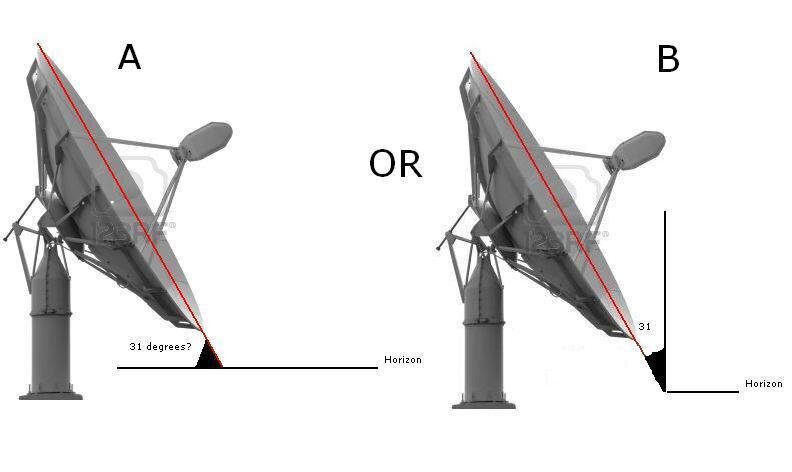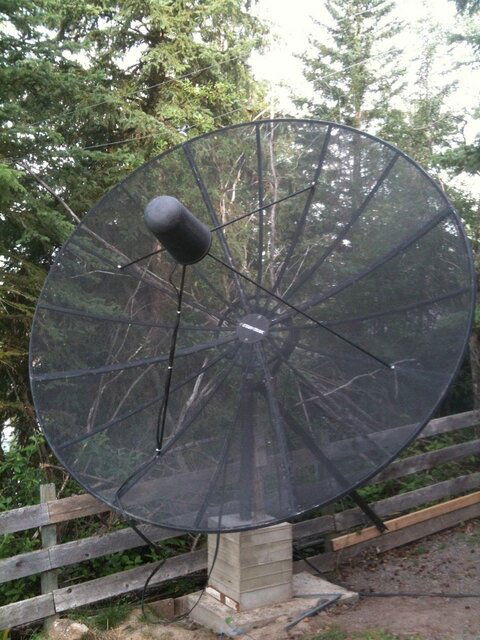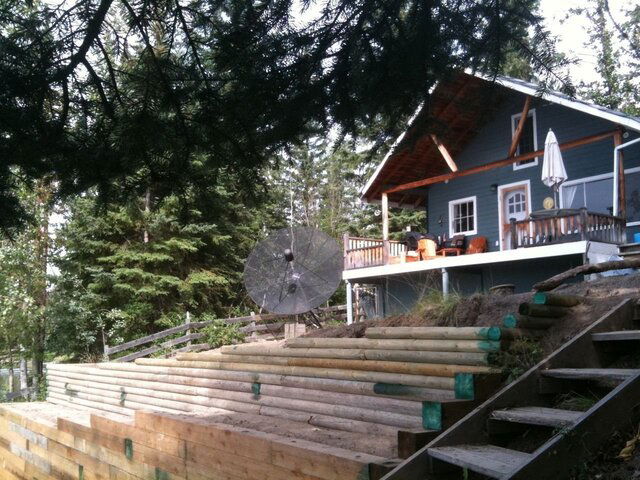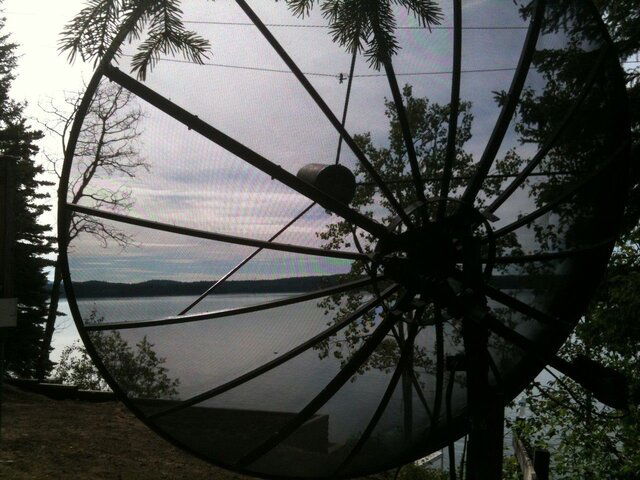A question for SatelliteAV - where did you get compass reading 131 degrees for 121W? Dishpointer says to use 162 degrees on the compass which is what I had been using for my true south sat.
C band set up - cannot lock on any birds
- Thread starter BuckmasterBC
- Start date
- Latest activity Latest activity:
- Replies 55
- Views 8K
You are using an out of date browser. It may not display this or other websites correctly.
You should upgrade or use an alternative browser.
You should upgrade or use an alternative browser.
- Status
- Please reply by conversation.
Horizontal = flat or Zero degrees. Vertical = straight up or 90 degrees. 1/3 of the way from flat up is 30 degrees. The nose needs to come down. At the north pole you look into the ground. At the equator, straight up in Portland OR halfway in between. In BC 'git 'er down a bit.
A question for SatelliteAV - where did you get compass reading 131 degrees for 121W? Dishpointer says to use 162 degrees on the compass which is what I had been using for my true south sat.
Sorry..... My bad! That is what happens when you type before coffee! The 3 is right below the 6 on my extended keyboard. You are correct, the compass reading is 161.1W
View attachment GeoSatFinder_BC.pdf
For starters, it sounds like the dish elevation angle is set WAY to high for your location and you are shooting far, far , far above the satellites!
Good Luck!
- For your location, the face of your dish needs to be set at approximately 31 degrees at the apex (top) of the arc with the dish centered on its mount. This angle is the result of using the modified polar mount setting and the declination of 6.70 degrees. When the dish is perfectly centered on the mount, use a straight edge placed on the rim of the dish on the vertical axis. Make sure the dish face elevation angle is set at approximately 31 degrees.
If it's not clear that I am desperately trying to find something wrong with my angles...here is another point of clarification. How do I exactly measure the 31 degrees - from the veritical axis I suspect (ie 90 degrees to the horizon?) - option B attached?
Attachments
BuckmasterBC said:How do I exactly measure the 31 degrees - from the veritical axis I suspect (ie 90 degrees to the horizon?) - option B attached?
Use "B" measurement. The true south satellite for your location located 31 degrees above the horizon. If the dish were aimed at the horizon this would be zero (0) degrees. Straight up would be 90 degrees. You want to aim the face of the dish at a point 31 degrees above the horizon.
Use "B" measurement. The true south satellite for your location located 31 degrees above the horizon. If the dish were aimed at the horizon this would be zero (0) degrees. Straight up would be 90 degrees. You want to aim the face of the dish at a point 31 degrees above the horizon.
I just went back through my posts to confirm - I did measure the "A" measurement and it was 59 degrees which means the "B" measurement is at 31 degrees already. I will walk through the steps that you proposed in your earlier post and start changing the elevation one degree at a time, etc and re-checking signal. Thanks for your help.
FaT Air said:One more thing may be off, the LNBF. Maybe it needs to be rotated 90°?
I will add that into my steps for trying to get some Q - I'll also take some pics next time I am up at the cabin and post them (although dial up is painful!). Sounds like turning the lnbf to 3 o'clock is a fairly common practice - does anyone know if this is true for a Openbox S9 with a DMX741 combination?
aprox 3 oclock should do the job!I have the same LNB and have used my solomend (same as the s9) with good results.
Thanks to all...finally locked on to the birds and all is well!! I was literally 5 minutes away from giving up entirely and ended up trying to lock onto 99W instead of my true south. I figured with all the help I had the dish was very close to perfectly set up. I slowly adjusted elevation as well as slight movements of the polar mount (a few degrees to each side of centre) - and voila...my elevation was out by about 5 degrees and my polar mount was off by probably 20 degrees! Anyway...I am watching ITC tonight thanks to all your help. BTW - my LNB was fine at 12 o'clock.
Once you have it tracking, it's a good idea to record your zenith angles and mark the pole to mount location. I know some have drilled a 1/4 inch hole thru the mount, into the pole. affording a great reference. If something were to get upset in the future -- ( I know my "swinging needle" angle finder is off a couple ) BTW: :up
Re: angles - I'll record the angles next time I am up at the cabin. I believe the final latitude angle ended up at about 55 degrees when I had it originally at 51 degrees. Moving the dish down did the job.
Re: marking the pole/mount - I did mark it with paint but I like the more permanent solution - I may etch it the next time I am up (about a month). In the meantime, I have included some pics of the dish and the view it has of the sky.
I have encountered an issue with my actuator as it gives a "no pulse response" error when I try to move the dish more than 2-3 satellite positions - I keep re-selecting the satellite and it continues to move but often stops with the jack error. I can slowly make it to the satellite position but it is painful and slow - I believe all the connections are correct, is this a sign the motor is dying? Maybe grease will help? I know my actuator mount is bent (pic attached) but it has been tracking the arc perfectly so I don't want to mess with it (not that I could bend it back anyway) ...thoughts? Are the bolts connecting the actuator to the mount and dish supposed to be tight or loose? It seems like when the motor needs to work harder it gives up and gives the "no pulse response - jack error" message (on the GI350i).
btw - like the new retaining walls I just built?
Re: marking the pole/mount - I did mark it with paint but I like the more permanent solution - I may etch it the next time I am up (about a month). In the meantime, I have included some pics of the dish and the view it has of the sky.
I have encountered an issue with my actuator as it gives a "no pulse response" error when I try to move the dish more than 2-3 satellite positions - I keep re-selecting the satellite and it continues to move but often stops with the jack error. I can slowly make it to the satellite position but it is painful and slow - I believe all the connections are correct, is this a sign the motor is dying? Maybe grease will help? I know my actuator mount is bent (pic attached) but it has been tracking the arc perfectly so I don't want to mess with it (not that I could bend it back anyway) ...thoughts? Are the bolts connecting the actuator to the mount and dish supposed to be tight or loose? It seems like when the motor needs to work harder it gives up and gives the "no pulse response - jack error" message (on the GI350i).
btw - like the new retaining walls I just built?
Attachments
Sensor problems - I put a "Grain 'o wheat lamp"(12 - 14V) or LED (with a proper value resistor) across the pulse leads. Watch it while the dish is being moved. You can see the pulses, and if it "skips" a pulse now and then or more."no pulse response" error
Excessive current draw by the actuator can also result in the error. The screw (internal to the tube), the extendable tube or a pivot that's corroded/binding, can all cause excessive current being drawn by the motor. Check with an ammeter in-line of one lead going to the motor. Should be under 3 amps. (mine will draw 2.5 amps lifting the dish off of extreme E or W, then settle around 1.25 amps or less through the rest of the arc.)
All the bolts should be tight, so there is no "slop". But all the pivot points should, well, pivot freely. If all pivots are free, screw and drive nut is lubed and in good condition, tube is clean and not binding and no skipping of pulses can be detected, then I would suspect the motor itself. But I think that's the least most common problem, Once everything is A-OK, apply some aerosol grease to the tube and pivots now and then to keep corrosion at bay and everything moving as it should.
BTW- I've seen a more than a few of those "accordion" boots actually trap water inside them, causing a lot of corrosion. Usually caused by the drain being plugged or too small, or not placed at the bottom. I don't use 'em. just grease the tube a few time a year. Most actuators should have a seal at the end of the tube, and if lubed, will do a respectable job sealing out moisture.
- Status
- Please reply by conversation.
Similar threads
- Replies
- 19
- Views
- 457
- Replies
- 9
- Views
- 501
- Replies
- 8
- Views
- 1K
- Replies
- 16
- Views
- 1K
- Replies
- 5
- Views
- 972






